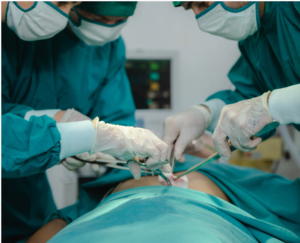Medical science has made significant leaps forward in the past few years. One of the most important advances in the field of surgery is that of laparoscopic surgery. Also known as “keyhole surgery” because it uses small incisions rather than larger ones. A majority of patients prefer this method because it’s more secure, speedier and more comfortable than traditional open surgeries.

The article will outline the procedure, its main benefits, and how it is superior to traditional surgical methods in easy-to-understand terminology.
What Is Laparoscopic Surgery?
Laparoscopic technique is a cutting-edge procedure that involves doctors making tiny cuts in the body, usually about a half-inch in length. Through these tiny cuts, they can insert a small tube, also known as a laparoscope, equipped with tiny cameras on the other end. The camera will transmit live images to the monitor, allowing doctors to see inside your body and prevent significant cuts.
This procedure is used to treat a range of medical issues, including gallbladder removal, hernia repair, appendix removal, and certain surgeries for gynaecological or kidney conditions.
With smaller incisions and advances in technology, patients recover faster than with traditional open surgeries.
1. Smaller Cuts and Less Pain
One of the significant advantages of laparoscopic surgery is that it makes small incisions. Traditional surgeries generally require a lengthy incision, which can be painful and require a longer healing time.
Laparoscopic surgery is a less painful procedure that results in less postoperative discomfort. Minor cuts will also require fewer painkillers, and you’ll feel more relaxed in the first few days.
2. Faster Recovery Time
Another benefit is speedier recovery. Since surgery does less harm to the body’s structure, it is possible to resume normal activities more quickly.
In the majority of cases, patients can go home the next morning or within the 24-hour period after the procedure, depending on their medical condition. In contrast, conventional surgery may require hospitalisation for a specific period.
A quicker recovery means you can return to your job, family life, and everyday routines without waiting long.
3. Minimal Scarring
The standard surgical procedure results in a noticeable and visible scar that may cause discomfort. But when you go through laparoscopic procedures, the incisions are so tiny that they’re virtually unnoticeable.
4. Less Risk of Infection
Smaller incisions mean a lower risk of infection. During laparoscopic surgery, because the surgical site isn’t open, germs and bacteria are less likely to enter.

It’s a better choice for many patients, including those with weaker immune systems or medical conditions.
5. Quicker Return to Normal Life
With fewer accidents, less pain and faster recovery, you’ll be back to your routine sooner. It doesn’t matter if you’re back at work, exercising, or having a relaxing time with your loved ones; laparoscopic surgery can help you recover quickly.
This is one of the main reasons that more people are opting for this method of treatment in place of traditional open surgery.
6. High Precision and Better Results
Laparoscopic surgery can be performed with high-definition cameras. Surgeons can see internal organs more clearly on the monitor. This gives them a clearer image of the organs and enables them to perform precise actions.
This allows surgeons to complete the procedure more efficiently and without complications. Patients usually achieve better overall results than with open surgery.
7. Less Post-Surgery Care Needed
If you’ve had Laparoscopic Surgery, it isn’t mandatory to receive any follow-up treatments as you would for conventional surgeries. The wounds aren’t too large and heal quickly.
8. Suitable for Many Conditions
Laparoscopic operation is utilised in various medical procedures, including:
- The gallbladder is removed
- Repair of hernias
- Appendix Removal
- Gynaecological surgery (like taking out an ovarian cyst, or a Hysterectomy)
- Kidney surgeries
- The Bariatric (weight-loss) procedures
Because of its effectiveness and safety, it’s often recommended by medical professionals for various procedures.
Conclusion
Laparoscopic procedures have changed the way surgeries are performed today. With minor cuts that cause less pain and scarring and speed healing, patients can get back to everyday life faster and feel more secure.
If your doctor suggests laparoscopic surgery for you, it’s a brand new, well-established, effective, and reliable procedure that you can count on. Make sure to talk with your surgeon about your options to determine what is best for your overall health.
FAQs About Laparoscopic Surgery
1. Is laparoscopic surgery harmful?
It’s not a huge deal and, in actuality, it’s pretty simple. You may feel some discomfort for a few hours, but it’s less invasive and more comfortable than conventional operations due to the tiny cuts.
2. How do I recover after laparoscopic surgery?
Most patients recover within one or two weeks, depending upon the type of procedure. Many patients return to their normal activities within a few days.
3. Are there any risk factors in laparoscopic surgery?
Like any other procedure, there are some risks, but they are much lower than those for open surgery. The doctor will discuss the risks before your procedure.
4. Are all surgeries possible with laparoscopic techniques?
However, not all surgeries may be performed with this method. It depends on your medical conditions and your physician’s advice.
5. Are there any marks after laparoscopic surgery?
The wounds are not significant and will fade with time. They are smaller than the wounds that are left after traditional surgeries.


